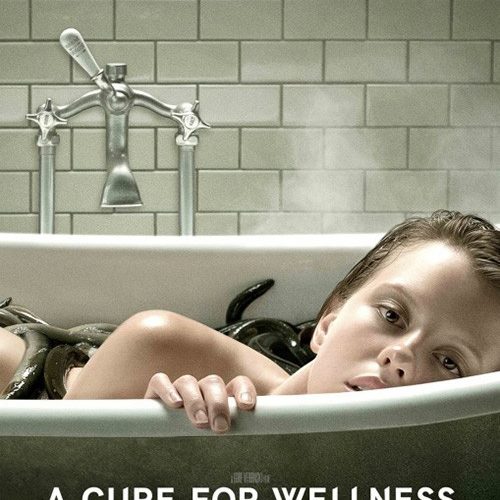The asylum-based film is a fairly interesting mini-genre to deconstruct. These movies almost always deal with perceptions of reality, questions of the self, and an innate fear of those in positions of power who operate in worlds of the ethereal. The question of the protagonist’s madness is almost always central, and the uncertainty over whether their paranoia is unfounded or justified is from where the story often derives its most potent thrills.
A Cure for Wellness, while not taking place in an asylum per se, hews so closely to and borrows so readily from the genre that it is impossible not to take the film as such. Which makes some of the narrative choices hard to understand, as they ultimately drain the uncertain paranoia from its story in exchange for ever-escalating set pieces composed of bizarre, disturbing imagery. It is all of the harrowing horror of an asylum film with none of the deeper, more disconcerting subtext or mind-bending logic puzzles — a film not entirely devoid of merit, but nonetheless hobbled by poor storytelling.

More’s the pity, because at the outset A Cure for Wellness comes on strong as a solid and moodily shot paranoid triumph. A New York financial firm is about to take part in a merger that will make it a powerhouse — so long as nothing goes wrong with the federal investigation. Matters are complicated by the fact that their CEO, Pembroke, who is in the Swiss Alps at a sort of spa, has sent a letter that makes it sound as though he has lost his mind. The board of directors — stoic, stone-faced ciphers who make for a bizarrely compelling set of Fates — decide that young, troubled executive Lockhart (Dane DeHaan) should be sent to retrieve him so that he can take the fall for any wrongdoing uncovered. It’s a complicated set up, but one that sets both personal and professional stakes for our protagonist that make some of his more irrational choices seem much more logical.
Director Gore Verbinski, of Pirates of the Caribbean and The Ring fame, uses the genre and setting — the spa is located in a castle on a mountain top at the foot of the Alps — to flex his visual acumen to maximum effect. Trailers used the overwrought “visionary” descriptor for Verbinski, but it is hard to argue with the title given the look of this film. Hardly a scene goes by without at least two immediately striking shots, and these perception-arresting images serve as the more visceral drive underneath the plot’s creaky forward momentum.

Much of what follows is equally compelling. Lockhart butts heads with hospital staff who want to keep him from Pembroke. Eerie stories about the history of the castle are told in whispers and between breaths. Friction between the institute and the town is established via shots of unruly teens staring hatefully. With these plot pieces and oppressively strange images, the stage seems set for a twisting yarn of hidden histories and mental mysteries.
Sadly, the film never truly immerses its character or audience into the world of confusion and faulty perception that one might expect. Following a car accident that leaves him with a broken leg, Lockhart is confined to the facility, but enters into every step of the cryptic treatment voluntarily. He never truly believes that anything is wrong with him, and nothing in the narrative would make us believe that there is, either. Every time he learns more about the history of the castle, information comes like a bolt out of the blue, and usually with the same rhythm of delivery. Lockhart mentions some bit of knowledge he has, the other person looks at him in confusion, and then adds their piece to the story to clarify his misinformation.
It turns the storytelling from a voyage of discovery into a series of exposition clips, robbing most of the participatory fun out of this endeavor. Further, the more lore that gets piled on and the more weirdness that occurs, the more Lockhart’s continued collaboration — the fact that he very easily comes and goes as he pleases — becomes increasingly less understandable and forgivable. Towards the end, a muddled mythology and his already-compromised decisions make it hard to tell if he has broken or is simply playing along for fun. The mechanics of the place are painstakingly explored, but never fully understood.

There are threads of interest all the way through A Cure for Wellness — a lullaby that repeats in strange places, visions of eels, menacing glasses and carafes of water — but most of these things are left floating in the ether by the time the credits roll. The deeper we get into the story, the harder it is to discern how the building blocks screenwriter Justin Haythe has laid out fit together. All of those surreal images become nothing more than awe-inspiring affectations that don’t add any meaning to the story itself. It is style for the sake of style with none of the integral tactility of something like Shutter Island, which this film clearly admires.
Still, there is something to praise about a film that so heartily and earnestly pursues its strange delights. A number of scenes will be stuck in the mind long after the lights go up, and Dane DeHaan makes for a compelling presence — to say nothing of Jason Isaacs, who delivers a delightfully creepy performance as head doctor Volmer. Yet all of these things, worthy of praise as they are, remain suspended in the miasma of a story so unfocused that it feels like it is still being explained well past the point of climax.
A Cure for Wellness opens nationwide on Friday, February 17.

